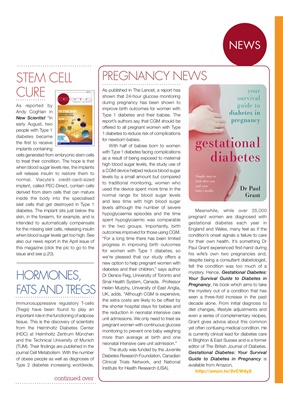
NEWS
PREGNANCY NEWS
As published in The Lancet, a report has
shown that 24-hour glucose monitoring
during pregnancy has been shown to
improve birth outcomes for women with
Type 1 diabetes and their babies. The
report's authors say that continuous
glucose monitoring should be offered to all
pregnant women with Type 1 diabetes to
reduce risk of complications for newborn
babies
With half of babies born to women
with Type 1 diabetes facing complications
as a result of being exposed to maternal
high blood sugar levels, the study use of
a CGM device helped reduce blood sugar
levels by a small amount but compared
to traditional monitoring, women who
used the device spent more time in the
normal range for blood sugar levels
and less time with high blood sugar
levels although the number of severe
hypoglycaemia episodes and the time
spent hypoglycaemic was comparable
in the two groups. Importantly, birth
outcomes improved for those using CGM.
"For a long time there has been limited
progress in improving birth outcomes
for women with Type 1 diabetes, so
we're pleased that our study offers a
new option to help pregnant women with
diabetes and their children," says author
Dr Denice Feig, University of Toronto and
Sinai Health System, Canada. Professor
Helen Murphy, University of East Anglia,
UK, adds, "Although CGM is expensive,
the extra costs are likely be offset by the
shorter hospital stays for babies and the
reduction in neonatal intensive care unit
admissions. We only need to treat six
pregnant women with continuous glucose
monitoring to prevent one baby weighing
more than average at birth and one
neonatal intensive care unit admission."
The study was funded by the Juvenile
Diabetes Research Foundation, Canadian
Clinical Trials Network, and National
Institute for Health Research (USA).
As reported by
Andy Coghlan in
New Scientist "In
early August, two
people with Type 1
diabetes became
the first to receive
implants containing
cells generated from embryonic stem cells
to treat their condition. The hope is that
when blood sugar levels rise, the implants
will release insulin to restore them to
normal. Viacyte's credit-card-sized
implant, called PEC-Direct, contain cells
derived from stem cells that can mature
inside the body into the specialised
islet cells that get destroyed in Type 1
diabetes. The implant sits just below the
skin, in the forearm, for example, and is
intended to automatically compensate
for the missing islet cells, releasing insulin
when blood sugar levels get too high. See
also our news report in the May issue of
this magazine (click the pic to go to the
issue, see p. 20).
STEM CELL
CURE
Meanwhile, while over 35,000
pregnant women are diagnosed with
gestational diabetes each year in
England and Wales, many feel as if the
condition's onset signals a failure to care
for their own health. It's something Dr
Paul Grant experienced first-hand during
his wife's own two pregnancies and,
despite being a consultant diabetologist,
felt the condition was too much of a
mystery. Hence, Gestational Diabetes:
Your Survival Guide to Diabetes in
Pregnancy, his book which aims to take
the mystery out of a condition that has
seen a three-fold increase in the past
decade alone. From initial diagnosis to
diet changes, lifestyle adjustments and
even a series of complementary recipes,
Grant gives advice about this common
yet often confusing medical condition. He
is currently clinical lead for diabetes care
in Brighton & East Sussex and is a former
editor of The British Journal of Diabetes.
Gestational Diabetes: Your Survival
Guide to Diabetes in Pregnancy is
available from Amazon,
http://amzn.to/2vcwdy2
ISSUE 78
DIABETES MAGAZINE
DESANG
IN THE BAG
A research report on
Cell Pouch technology
MAKING
CARBS
COUNT:
GREEK YOGHURT
PLUS • Diabetes kit • Giveaways • News (for T1 and T2) • Food News
An update on
the BiAP
PLUS
Immunosuppressive regulatory T-cells
(Tregs) have been found to play an
important role in the functioning of adipose
tissue. This is the discovery of scientists
from the Helmholtz Diabetes Center
(HDC) at Helmholtz Zentrum München
and the Technical University of Munich
(TUM). Their findings are published in the
journal Cell Metabolism. With the number
of obese people as well as diagnoses of
Type 2 diabetes increasing worldwide,
continued over
HORMONES,
FATS AND TREGS